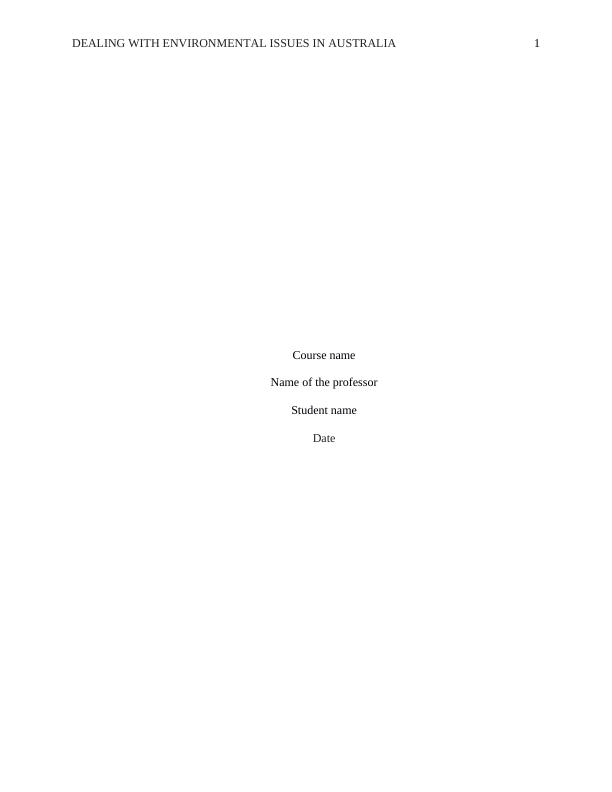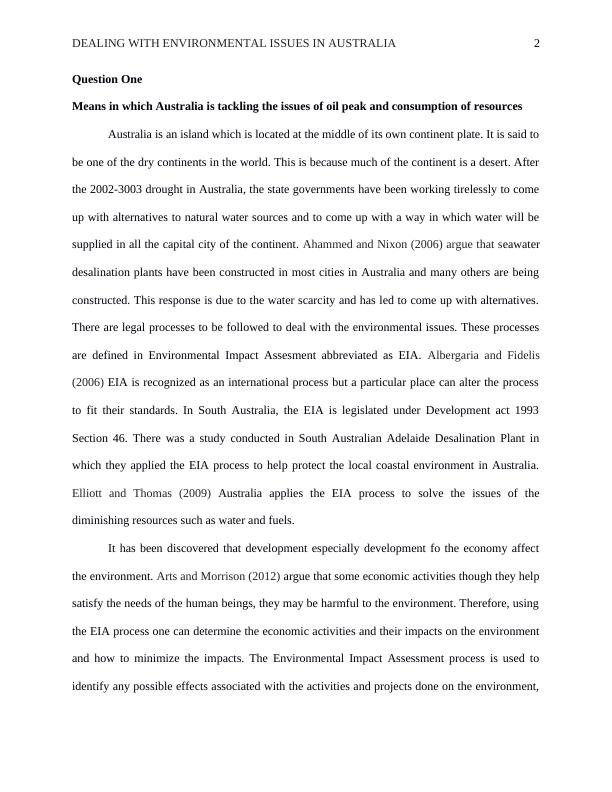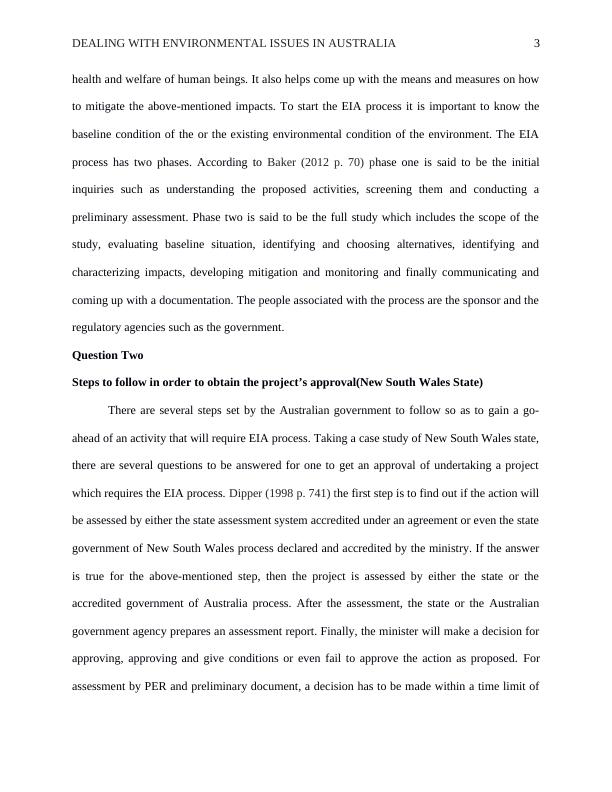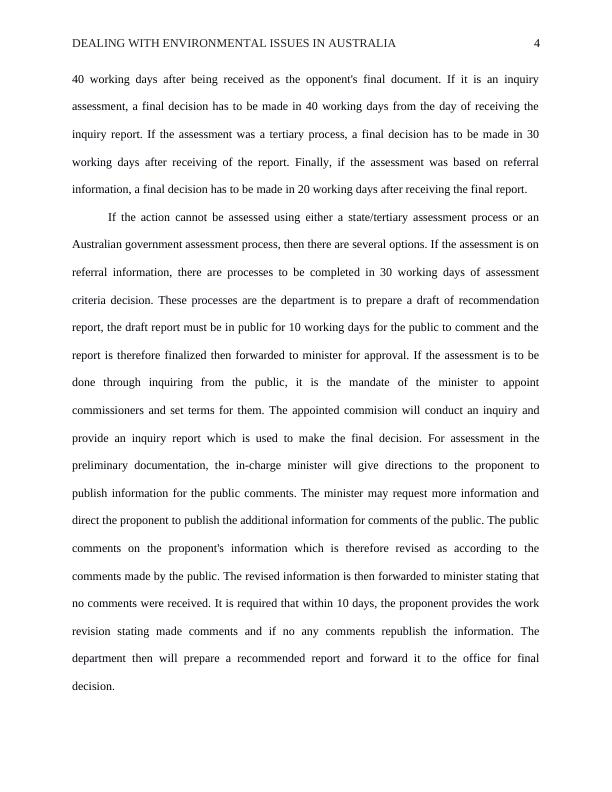Dealing with Environmental Issues in Australia - Desklib
Added on 2023-06-07
11 Pages3191 Words446 Views
DEALING WITH ENVIRONMENTAL ISSUES IN AUSTRALIA 1
Course name
Name of the professor
Student name
Date
Course name
Name of the professor
Student name
Date

DEALING WITH ENVIRONMENTAL ISSUES IN AUSTRALIA 2
Question One
Means in which Australia is tackling the issues of oil peak and consumption of resources
Australia is an island which is located at the middle of its own continent plate. It is said to
be one of the dry continents in the world. This is because much of the continent is a desert. After
the 2002-3003 drought in Australia, the state governments have been working tirelessly to come
up with alternatives to natural water sources and to come up with a way in which water will be
supplied in all the capital city of the continent. Ahammed and Nixon (2006) argue that seawater
desalination plants have been constructed in most cities in Australia and many others are being
constructed. This response is due to the water scarcity and has led to come up with alternatives.
There are legal processes to be followed to deal with the environmental issues. These processes
are defined in Environmental Impact Assesment abbreviated as EIA. Albergaria and Fidelis
(2006) EIA is recognized as an international process but a particular place can alter the process
to fit their standards. In South Australia, the EIA is legislated under Development act 1993
Section 46. There was a study conducted in South Australian Adelaide Desalination Plant in
which they applied the EIA process to help protect the local coastal environment in Australia.
Elliott and Thomas (2009) Australia applies the EIA process to solve the issues of the
diminishing resources such as water and fuels.
It has been discovered that development especially development fo the economy affect
the environment. Arts and Morrison (2012) argue that some economic activities though they help
satisfy the needs of the human beings, they may be harmful to the environment. Therefore, using
the EIA process one can determine the economic activities and their impacts on the environment
and how to minimize the impacts. The Environmental Impact Assessment process is used to
identify any possible effects associated with the activities and projects done on the environment,
Question One
Means in which Australia is tackling the issues of oil peak and consumption of resources
Australia is an island which is located at the middle of its own continent plate. It is said to
be one of the dry continents in the world. This is because much of the continent is a desert. After
the 2002-3003 drought in Australia, the state governments have been working tirelessly to come
up with alternatives to natural water sources and to come up with a way in which water will be
supplied in all the capital city of the continent. Ahammed and Nixon (2006) argue that seawater
desalination plants have been constructed in most cities in Australia and many others are being
constructed. This response is due to the water scarcity and has led to come up with alternatives.
There are legal processes to be followed to deal with the environmental issues. These processes
are defined in Environmental Impact Assesment abbreviated as EIA. Albergaria and Fidelis
(2006) EIA is recognized as an international process but a particular place can alter the process
to fit their standards. In South Australia, the EIA is legislated under Development act 1993
Section 46. There was a study conducted in South Australian Adelaide Desalination Plant in
which they applied the EIA process to help protect the local coastal environment in Australia.
Elliott and Thomas (2009) Australia applies the EIA process to solve the issues of the
diminishing resources such as water and fuels.
It has been discovered that development especially development fo the economy affect
the environment. Arts and Morrison (2012) argue that some economic activities though they help
satisfy the needs of the human beings, they may be harmful to the environment. Therefore, using
the EIA process one can determine the economic activities and their impacts on the environment
and how to minimize the impacts. The Environmental Impact Assessment process is used to
identify any possible effects associated with the activities and projects done on the environment,

DEALING WITH ENVIRONMENTAL ISSUES IN AUSTRALIA 3
health and welfare of human beings. It also helps come up with the means and measures on how
to mitigate the above-mentioned impacts. To start the EIA process it is important to know the
baseline condition of the or the existing environmental condition of the environment. The EIA
process has two phases. According to Baker (2012 p. 70) phase one is said to be the initial
inquiries such as understanding the proposed activities, screening them and conducting a
preliminary assessment. Phase two is said to be the full study which includes the scope of the
study, evaluating baseline situation, identifying and choosing alternatives, identifying and
characterizing impacts, developing mitigation and monitoring and finally communicating and
coming up with a documentation. The people associated with the process are the sponsor and the
regulatory agencies such as the government.
Question Two
Steps to follow in order to obtain the project’s approval(New South Wales State)
There are several steps set by the Australian government to follow so as to gain a go-
ahead of an activity that will require EIA process. Taking a case study of New South Wales state,
there are several questions to be answered for one to get an approval of undertaking a project
which requires the EIA process. Dipper (1998 p. 741) the first step is to find out if the action will
be assessed by either the state assessment system accredited under an agreement or even the state
government of New South Wales process declared and accredited by the ministry. If the answer
is true for the above-mentioned step, then the project is assessed by either the state or the
accredited government of Australia process. After the assessment, the state or the Australian
government agency prepares an assessment report. Finally, the minister will make a decision for
approving, approving and give conditions or even fail to approve the action as proposed. For
assessment by PER and preliminary document, a decision has to be made within a time limit of
health and welfare of human beings. It also helps come up with the means and measures on how
to mitigate the above-mentioned impacts. To start the EIA process it is important to know the
baseline condition of the or the existing environmental condition of the environment. The EIA
process has two phases. According to Baker (2012 p. 70) phase one is said to be the initial
inquiries such as understanding the proposed activities, screening them and conducting a
preliminary assessment. Phase two is said to be the full study which includes the scope of the
study, evaluating baseline situation, identifying and choosing alternatives, identifying and
characterizing impacts, developing mitigation and monitoring and finally communicating and
coming up with a documentation. The people associated with the process are the sponsor and the
regulatory agencies such as the government.
Question Two
Steps to follow in order to obtain the project’s approval(New South Wales State)
There are several steps set by the Australian government to follow so as to gain a go-
ahead of an activity that will require EIA process. Taking a case study of New South Wales state,
there are several questions to be answered for one to get an approval of undertaking a project
which requires the EIA process. Dipper (1998 p. 741) the first step is to find out if the action will
be assessed by either the state assessment system accredited under an agreement or even the state
government of New South Wales process declared and accredited by the ministry. If the answer
is true for the above-mentioned step, then the project is assessed by either the state or the
accredited government of Australia process. After the assessment, the state or the Australian
government agency prepares an assessment report. Finally, the minister will make a decision for
approving, approving and give conditions or even fail to approve the action as proposed. For
assessment by PER and preliminary document, a decision has to be made within a time limit of

DEALING WITH ENVIRONMENTAL ISSUES IN AUSTRALIA 4
40 working days after being received as the opponent's final document. If it is an inquiry
assessment, a final decision has to be made in 40 working days from the day of receiving the
inquiry report. If the assessment was a tertiary process, a final decision has to be made in 30
working days after receiving of the report. Finally, if the assessment was based on referral
information, a final decision has to be made in 20 working days after receiving the final report.
If the action cannot be assessed using either a state/tertiary assessment process or an
Australian government assessment process, then there are several options. If the assessment is on
referral information, there are processes to be completed in 30 working days of assessment
criteria decision. These processes are the department is to prepare a draft of recommendation
report, the draft report must be in public for 10 working days for the public to comment and the
report is therefore finalized then forwarded to minister for approval. If the assessment is to be
done through inquiring from the public, it is the mandate of the minister to appoint
commissioners and set terms for them. The appointed commision will conduct an inquiry and
provide an inquiry report which is used to make the final decision. For assessment in the
preliminary documentation, the in-charge minister will give directions to the proponent to
publish information for the public comments. The minister may request more information and
direct the proponent to publish the additional information for comments of the public. The public
comments on the proponent's information which is therefore revised as according to the
comments made by the public. The revised information is then forwarded to minister stating that
no comments were received. It is required that within 10 days, the proponent provides the work
revision stating made comments and if no any comments republish the information. The
department then will prepare a recommended report and forward it to the office for final
decision.
40 working days after being received as the opponent's final document. If it is an inquiry
assessment, a final decision has to be made in 40 working days from the day of receiving the
inquiry report. If the assessment was a tertiary process, a final decision has to be made in 30
working days after receiving of the report. Finally, if the assessment was based on referral
information, a final decision has to be made in 20 working days after receiving the final report.
If the action cannot be assessed using either a state/tertiary assessment process or an
Australian government assessment process, then there are several options. If the assessment is on
referral information, there are processes to be completed in 30 working days of assessment
criteria decision. These processes are the department is to prepare a draft of recommendation
report, the draft report must be in public for 10 working days for the public to comment and the
report is therefore finalized then forwarded to minister for approval. If the assessment is to be
done through inquiring from the public, it is the mandate of the minister to appoint
commissioners and set terms for them. The appointed commision will conduct an inquiry and
provide an inquiry report which is used to make the final decision. For assessment in the
preliminary documentation, the in-charge minister will give directions to the proponent to
publish information for the public comments. The minister may request more information and
direct the proponent to publish the additional information for comments of the public. The public
comments on the proponent's information which is therefore revised as according to the
comments made by the public. The revised information is then forwarded to minister stating that
no comments were received. It is required that within 10 days, the proponent provides the work
revision stating made comments and if no any comments republish the information. The
department then will prepare a recommended report and forward it to the office for final
decision.

End of preview
Want to access all the pages? Upload your documents or become a member.
Related Documents
Using Soft Tools to Control Energy Demand at Peak Timelg...
|11
|3148
|217
Sustainable System Report - Environmental Issues | Australialg...
|13
|2461
|42
Victorian Desalination Project - Doclg...
|11
|2314
|121
Essay on Environmental Impact Assessment (EIA)lg...
|12
|2791
|483
Sustainable System: Revisiting the Limits to Growth and Environmental Impact Assessmentlg...
|20
|4007
|83
Business Researchlg...
|14
|3863
|26
